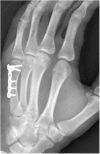Three-screw versus two-screw fixation of distal fragment in fifth metacarpal neck fractures stabilized with locking plate
- PMID: 28970518
- PMCID: PMC5624927
- DOI: 10.1038/s41598-017-12771-z
Three-screw versus two-screw fixation of distal fragment in fifth metacarpal neck fractures stabilized with locking plate
Abstract
Fifth metacarpal neck fracture commonly requires open reduction and internal fixation. Locking plate was widely adopted in the treatment of fifth metacarpal neck fracture as first-line choice for fixation. Patients with fifth metacarpal neck fracture receiving locking plate fixation were included for analysis. Features of internal fixation including number of distal and proximal locking screws, diameter of the screws and usage of lag screws were recorded. Clinical and radiographic outcomes included final volar angulation, grip strength, Michigan Hand Outcomes Questionnaire (MHQ) and range of motion (ROM) of fifth metacarpophalangeal joint. Three-screw fixation was less frequently presented in the group with increased volar angulation (≥30 degrees). Consistently, three-screw fixation of distal fragment could improve the prognosis compared with two-screw fixation (MHQ 95.4 ± 5.1 versus 80.4 ± 12.3, ROM 83.5 ± 7.2 versus 69.6 ± 7.7). In conclusion, the metacarpal head should be fixed by three locking screws instead of two locking screws.
Conflict of interest statement
The authors declare that they have no competing interests.
Figures
Similar articles
-
Locking Plate Alone versus in Combination with Two Crossed Kirschner Wires for Fifth Metacarpal Neck Fracture.Sci Rep. 2017 Apr 5;7:46109. doi: 10.1038/srep46109. Sci Rep. 2017. PMID: 28378776 Free PMC article.
-
Antegrade intramedullary pinning versus retrograde intramedullary pinning for displaced fifth metacarpal neck fractures.Clin Orthop Relat Res. 2015 May;473(5):1747-54. doi: 10.1007/s11999-014-4079-7. Epub 2014 Dec 11. Clin Orthop Relat Res. 2015. PMID: 25502343 Free PMC article. Clinical Trial.
-
Biomechanical analysis of locking plates for fixation of metacarpal shaft fractures: A finite element analysis.Orthop Traumatol Surg Res. 2022 Dec;108(8):103340. doi: 10.1016/j.otsr.2022.103340. Epub 2022 May 25. Orthop Traumatol Surg Res. 2022. PMID: 35643362
-
Extraarticular hand fractures in adults: a review of new developments.Clin Orthop Relat Res. 2006 Apr;445:133-45. doi: 10.1097/01.blo.0000205888.04200.c5. Clin Orthop Relat Res. 2006. PMID: 16505726 Review.
-
Optimal Positioning for Volar Plate Fixation of a Distal Radius Fracture: Determining the Distal Dorsal Cortical Distance.Orthop Clin North Am. 2016 Jan;47(1):235-44. doi: 10.1016/j.ocl.2015.08.020. Orthop Clin North Am. 2016. PMID: 26614937 Review.
Cited by
-
Single versus dual elastic nails for closed reduction and antegrade intramedullary nailing of displaced fifth metacarpal neck fractures.Sci Rep. 2021 Jan 19;11(1):1778. doi: 10.1038/s41598-021-81242-3. Sci Rep. 2021. PMID: 33469102 Free PMC article.
References
-
- Potenza V, Caterini R, De Maio F, Bisicchia S, Farsetti P. Fractures of the neck of the fifth metacarpal bone. Medium-term results in 28 cases treated by percutaneous transverse pinning. Injury. 2012;43:242–5. - PubMed
Publication types
MeSH terms
LinkOut - more resources
Full Text Sources
Other Literature Sources
Medical


